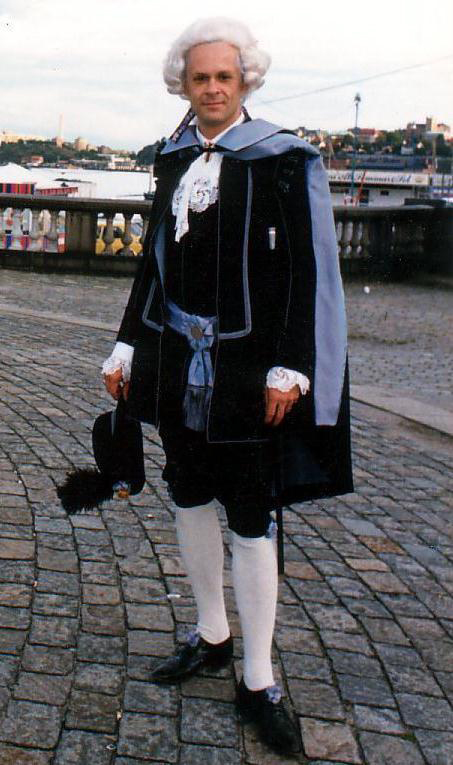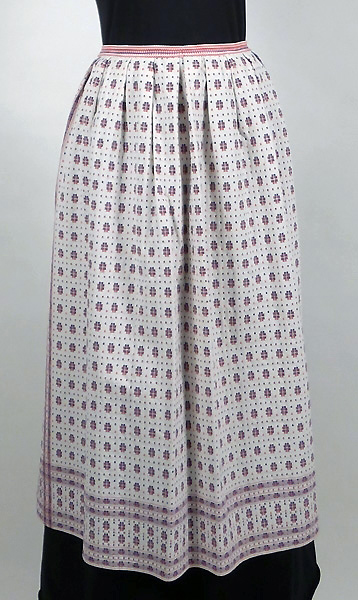Blue and yellow: the Swedish national costume
We wanted to offer a little history on nationella dräkten, the national costume, and in our research we discovered there is more to the blue and yellow than meets the eye.
-
 Male version of the National costume (Nationella dräkten or Svenska Nationella klädedräkten, right) Photo: Southerly Clubs of Stockholm.
Male version of the National costume (Nationella dräkten or Svenska Nationella klädedräkten, right) Photo: Southerly Clubs of Stockholm. -
-
To one degree or another, we knew we had Queen Silvia to thank for bringing the Sweden costume into fashion when she wore it on June 6, 1983, the first time Sweden’s National Day* was celebrated.
-
 The beautiful apron of the Vadsbo costume of Västergötland.
The beautiful apron of the Vadsbo costume of Västergötland. -
-
The concept of a Swedish national costume can actually be traced back to the 18th century. It was originally designed and introduced by King Gustav III in 1778 as Svenska Nationella Klädedräkten (the Swedish National Costume)**. He intended it to be worn by the nobility and middle class in a move to curb exorbitant spending on fashion. This reform, that stressed the importance of getting Swedes to stop emulating expensive foreign fashions, also stirred an interest in national romance in other countries. The French author and philosopher Voltaire expressed his admiration for the Swedish king while some other nations in Europe made fun of the king’s initiative.
Both the female and male costumes had specific color requirements for court functions: black with red trim for daily wear, and light blue with white trim for formal occasions. Other persons were free to choose their own color combinations as long as they maintained the two-tone design.
After the death of King Gustav III, it became the official uniform worn at court by ladies in waiting and a customary dress for women formally presented at Court. Over the years, the female costume followed the fashion of the era, except for its collar and vertically striped sleeves, and a specific color rule of black or very dark blue with white trim. It ended up with lasting effect, although modified several times, as the official costume of the Royal Court.
The male costume had more original designs and included details from the Renaissance and the Caroline period of Swedish history. It was worn at Court and by many officials during the reigns of Gustav III and his son Gustav IV Adolph. Eventually it had more limited use as a sort of folk costume for townsmen in Stockholm. -
 Crown Princess Victoria with Prince Daniel and Prince Carl Philip with Princess Sofia, both of the princesses in the Sverigedräkten, the Sweden costume. Wikimedia Commons.
Crown Princess Victoria with Prince Daniel and Prince Carl Philip with Princess Sofia, both of the princesses in the Sverigedräkten, the Sweden costume. Wikimedia Commons. -
Shifts in society
While the national costume was worn by the nobility and middle class, the majority of Swedes were farmers living in different regions of the country. Each region had distinct characteristics, but the peasants built their houses in the same fashion and ate the same food. In order to be distinct, every province had its own style of clothing, with every village displaying its history and culture through its outfits.
By the late 19th century, though, as development in Sweden accelerated, the peasant community was starting to wear more factory-made clothing and saving their folk costumes for festive occasions. And while the folk costume was increasingly considered a symbol of the old farming community, some settlements kept the older clothes far into the 20th century.
But in 1902, Märta Palme Jörgensen of Falun founded the Svenska Kvinnliga Nationaldräktsföreningen (Swedish Women's National Costume Association), which shifted ideals from “foreign fashions’ domination” yet again. She had worked with Crown Princess Victoria of Baden (who eventually reigned with her husband King Gustaf V until her death in 1930), who advocated for folk costumes and wanted her servants at Tullgarn Palace to wear the local Tullgarn folkdräkt (folk costume). As a gardener at Tullgarn, Jörgensen loved the freedom the dress gave her compared to long, corseted dresses that were in fashion. This inspired her to start the association, urging members to wear their costumes.
It became fashionable to wear costumes – and even Queen Victoria would wear Ölandsdräkten when she was at Solliden on Öland and the Vingåkersdräkt at Tullgarn.
It wasn’t long before the association recognized the need for men's costumes and the villages that lacked them. On the advice of Carl Larsson, whose wife Karin designed folk costumes for areas in Dalarna, Jörgensen contacted Gustaf Ankarcrona, who helped design the national Sweden costume for women in the Art Nouveau style of the time. Anders Zorn was also part of the production, which had an overarching aim to produce a practical costume that could be worn by all women. The costumes included the appropriately symbolic daisies, the yellow and blue of Sweden’s new flag (adopted in 1906) and life-giving red.
World War II brought about another change and the costumes fell into disuse again. It wasn’t until the mid-1970s, when the Nordic Museum in Stockholm saw a copy of the costume - at the time of unknown origin - from a woman in Leksand. Their search for the costume brought in several other preserved costumes and a men’s version in the same style was developed. Soon a new wave of interest in folk costumes emerged. In some geographical areas, there were still elders wearing apparel according to old costume.
Some towns, however, no longer had the appropriate materials for replicating the village costume, a discovery that prompted interest in designing completely new costumes. -
Reviving national romance
Then, in 1983, Queen Silvia wore the blue and yellow costume on Sweden’s National Day, the Sweden costume became the nation’s official dress and gained instant popularity again, nearly 80 years after its conception.
Nowadays the blue and yellow national costume is worn by royal women on some official occasions, representing the whole country. Men’s costumes are available in the same colors, but that version is not used as often on official events. Both women's and men's costumes are used for private celebrations. In the United States, we see more young boys wearing the male costume than their counterparts in Sweden; certainly many American girls and women wear the blue and yellow outfit during Swedish celebrations on this side of the Atlantic, too. And there are many Swedes in America and Swedish Americans who proudly wear the provincial or village folkdräkter from the regions of their ancestors. Queen Silvia - and all the royal princesses - often wear the Sweden costume, and Crown Princess Victoria now also has a brand new Vadsbo dress as she is the Duchess of Västergötland. -
*Prior to 1983, June 6 was celebrated as Svenska Flaggans Dag (the Swedish Flag Day). It didn’t become an official Swedish public holiday until 2005, replacing Annandag Pingst (Whit Monday).
-
**Sometimes also referred to as “the first” Swedish national costume. To separate the two very different costumes we refer to the today well-known blue and yellow version as the Sweden costume or Sweden dress.
-
-
